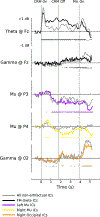EEG power spectral dynamics associated with listening in adverse conditions
- PMID: 34161612
- PMCID: PMC8355203
- DOI: 10.1111/psyp.13877
EEG power spectral dynamics associated with listening in adverse conditions
Abstract
Adverse listening conditions increase the demand on cognitive resources needed for speech comprehension. In an exploratory study, we aimed to identify independent power spectral features in the EEG useful for studying the cognitive processes involved in this effortful listening. Listeners performed the coordinate response measure task with a single-talker masker at a 0-dB signal-to-noise ratio. Sounds were left unfiltered or degraded with low-pass filtering. Independent component analysis (ICA) was used to identify independent components (ICs) in the EEG data, the power spectral dynamics of which were then analyzed. Frontal midline theta, left frontal, right frontal, left mu, right mu, left temporal, parietal, left occipital, central occipital, and right occipital clusters of ICs were identified. All IC clusters showed some significant listening-related changes in their power spectrum. This included sustained theta enhancements, gamma enhancements, alpha enhancements, alpha suppression, beta enhancements, and mu rhythm suppression. Several of these effects were absent or negligible using traditional channel analyses. Comparison of filtered to unfiltered speech revealed a stronger alpha suppression in the parietal and central occipital clusters of ICs for the filtered speech condition. This not only replicates recent findings showing greater alpha suppression as listening difficulty increases but also suggests that such alpha-band effects can stem from multiple cortical sources. We lay out the advantages of the ICA approach over the restrictive analyses that have been used as of late in the study of listening effort. We also make suggestions for moving into hypothesis-driven studies regarding the power spectral features that were revealed.
Keywords: ERSP; cocktail party; degraded speech; informational masking; oscillation.
© 2021 Society for Psychophysiological Research.
Figures






References
Publication types
MeSH terms
Grants and funding
LinkOut - more resources
Full Text Sources
Research Materials
Miscellaneous

